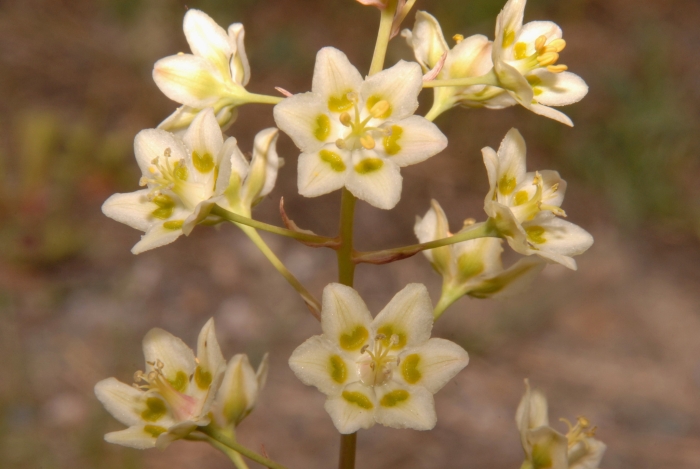Mountain Deathcamas
(Anticlea elegans)
Mountain Deathcamas (Anticlea elegans)
/
/

Brian Finzel
CC BY-SA 4.0
Image By:
Brian Finzel
Recorded By:
Copyright:
CC BY-SA 4.0
Copyright Notice:
Photo by: Brian Finzel | License Type: CC BY-SA 4.0 | License URL: http://creativecommons.org/licenses/by-sa/4.0/ | Rights Holder: Brian Finzel | Publisher: iNaturalist | Date Created: 2007-07-09T09:17:41-07:00 |

















Estimated Native Range
Summary
Anticlea elegans, commonly known as Mountain Deathcamas, is a toxic perennial herb native to a variety of habitats in North America, from Quebec to Alaska, including open meadows, forest clearings, and alpine zones. It typically grows to a height of 8-20 inches (20-50 cm) with grass-like leaves that form a basal rosette. The plant blooms from late spring to early summer, producing dense clusters of creamy white, lily-like flowers that are visually appealing but highly toxic. Each flower has a distinct two-pronged gland at the base of the petals. The fruit is a capsule containing black seeds.
Mountain Deathcamas is not commonly used in cultivation due to its toxicity, which poses a significant risk to humans and animals if ingested. However, its elegant appearance can be deceptive, making it important to recognize and avoid. In natural settings, it prefers well-drained soils and can tolerate a range of light conditions from full sun to partial shade. While not suitable for general garden use, it may be of interest for educational purposes in botanical gardens with proper warnings and safeguards in place. Its toxicity is due to the presence of steroidal alkaloids, which can be lethal. There are no popular garden cultivars of this species due to its poisonous nature.CC BY-SA 4.0
Mountain Deathcamas is not commonly used in cultivation due to its toxicity, which poses a significant risk to humans and animals if ingested. However, its elegant appearance can be deceptive, making it important to recognize and avoid. In natural settings, it prefers well-drained soils and can tolerate a range of light conditions from full sun to partial shade. While not suitable for general garden use, it may be of interest for educational purposes in botanical gardens with proper warnings and safeguards in place. Its toxicity is due to the presence of steroidal alkaloids, which can be lethal. There are no popular garden cultivars of this species due to its poisonous nature.CC BY-SA 4.0
Plant Description
- Plant Type: Herb, Bulb
- Height: 1-2 feet
- Width: 0.5-1 feet
- Growth Rate: Moderate
- Flower Color: White, Cream
- Flowering Season: Spring, Summer
- Leaf Retention: Deciduous
Growth Requirements
- Sun: Full Sun, Part Shade
- Water: Medium
- Drainage: Medium
Common Uses
Border Plant, Low Maintenance, Water Garden
Natural Habitat
native to a variety of habitats in North America, from Quebec to Alaska, including open meadows, forest clearings, and alpine zones
Other Names
Common Names: Mountain Death Camas, Elegant Camas, White Camas, Glaucous Death Camas, Smooth Camas
Scientific Names: , Anticlea elegans, Anticlea elegans var. elegans, Zigadenus elegans, Zigadenus elegans subsp. elegans, Zygadenus alpinus, Zygadenus bracteatus, Zygadenus canadensis, Zygadenus chloranthus, Zygadenus coloradensis
GBIF Accepted Name: